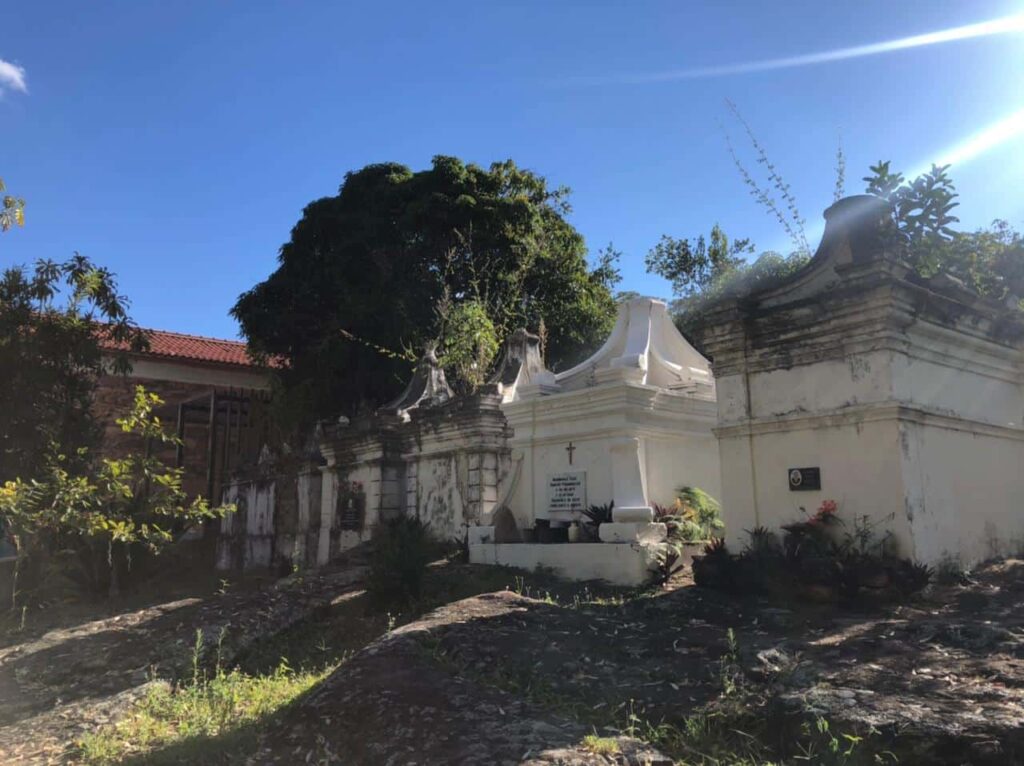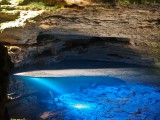Este post também está disponível em:
Português
English

Igatu, Poço Azul and Poço Encantado are one of the most important attractions of the Chapada Diamantina.
Igatu is a district of the municipality of Andaraí, in the state of Bahia, in Brazil.
Igatu has a historic stone house, from the 19th century, a remnant of the Diamond Cycle era in the Chapada Diamantina region.
For this characteristic, the district is known by the nickname “Machu Picchu baiana”, in a reference to the historic Peruvian city of stone.
Poço Azul and Poço Encantado have crystal clear water and the beauty of the places is formed by the combination of transparency and the blue reflection of the water, which at a time of the year gain a natural phenomenon that makes them even more fascinating.

Videos about Igatu, Poço Encantado and Poço Azul


Igatu, Poço Encantado e Poço Azul

Igatu na Chapada Diamantina

Igatu possui um casario histórico12:58

Igatu a “Machu Picchu” brasileira - Reportagem
See also the Tourist Spots of Chapada Diamantina
History of Igatu in Chapada Diamantina
The architectural, urban and landscape ensemble of Igatu – a district of the municipality of Andaraí – was listed by Iphan in 2000.
The city is also known as Xique-Xique do Igatu and Cidade de Pedras. The listing covers the ruins of stone dwellings located between the bridge over the Coisa Boa river and the left bank towards the trail of the old garimpo site.
The original foundations, dating from the mid-19th century, are in an excellent state of preservation and the perimeter has approximately 200 buildings.
Igatu is considered a living museum of the history of diamond mining in Brazil and, in the Art and Memory Gallery (an open-air museum) are utensils used by miners and slaves.
The small town of Igatu experienced the heyday and decline of diamond mining, leaving the signs of its history stamped in the architecture and lifestyle of the current residents.
Near the Piaba River, a tributary of the Paraguaçu River, it borders the Chapada Diamantina National Park. Through it pass the rivers Coisa Boa, Pombos, Laranjeiras and Tamburis.

Nestled among rocky outcrops, historic ruins, rivers and waterfalls, Iguatu has a historic 19th century house, built with stones and remnants of the diamond mining era in the region. Because of this characteristic, the district is known as the “Machu Picchu Baiana”, in a reference to the historic Peruvian city of stone.
In addition to the architecture of its layout and assets with individual value, the listing highlighted the historic ruins around the urban center built by the prospectors who worked in the locality.
Using Indian trails, slave labor, and building new paths, the prospectors almost completely overturned the Serra do Sincorá, transforming the region into one of the richest places in the world. A
the burrows and ranches of the early days began to coexist with large colonial mansions, which housed the diamond barons in their phase of splendor.
In the past – prosperous and populous – it had more than ten thousand inhabitants. However, with the decline of diamond mining in the region, it fell into decay and the majority of the population left the place in search of better living conditions.
The village of Igatu became empty, with abandoned houses and businesses. Despite the difficulties, some people resisted and remained in the place. Progressively, Igatu developed again and stood out in the Chapada Diamantina.
It currently attracts visitors from all over the world and tourism is its main economic activity. It is home to about 380 inhabitants, most of them children of diamond miners.
The town has a population of about 1,500.
The village of Igatu is a place conducive to historical-cultural tourism, as well as nature and adventure tourism, and is also known for being the birthplace of the writer Herberto Sales who immortalized Colonel Aureliano Gondim in his novel Cascalho. As occurred throughout the Northeast, the colonelism influenced the life and customs of the society of the municipality.

The white of the buildings contrasts with the always blue sky of the village stopped in time.
Map of the Trails and Tourist Spots of Chapada Diamantina
During the month of October 2008, the small village was the setting for the Brazilian movie Besouro.
Igatu’s architectural richness
The village of Igatu, which currently has around 500 inhabitants, was once one of the main mining areas in the region. In addition to the historic houses and churches, it still has the famous stone ruins, one of the remnants of the mining era.

Because they used irregular stones of different sizes and shapes, the miners built most of the walls of their houses like a sandwich: on the outside, they placed the larger stones, and on the inside, as a kind of filling, smaller stones, such as gravel.
Many walls and ramparts were made with dry joints, using small inlaid stone chips. The mortar for laying or coating (plastering) was made with clay and ash to give the alloy, covered with straw or tiles.
By using local materials and reused from another activity, these dwellings can be considered extremely sustainable”, highlights Liziane.

The stone and lime São Sebastião Church in the village of Igatu stands out in the Igatu landscape for its preservation. Next door and opposite are the equally well preserved Byzantine cemeteries.


Tourist attractions of Igatu

The garimpo do brejo is an old mine restructured for tourist visitation.
Another attraction is the Igatu art gallery.
Another interesting tourist spot is the climb to the Rampa do Caim, an easy walk of approximately ten kilometers, culminating in the viewpoint where you can have an impressive view of the Pati and Paraguaçu valleys.
About three hours walking to reach a place that gives one of the most spectacular views of the Pati Valley and the Paraguaçu and Preto rivers, both with their dark waters.
The trail is good and the arrival is not even mentioned, but you need to be very “zen” to enjoy the trail. You need to be very attentive because there are many loose and slippery stones and a fall there would not help at all.
The arrival requires one or more minutes of silence (contemplation, thanks to God, it is to listen to the silence and the grandeur of nature).
From there it is possible to move on, making a trail that will pass through Pati, Capão and Palmeiras, other immensely beautiful areas of Chapada Diamantina. The Rampa do Caim and the trail are also being explored by local agencies.
In recent years, Igatu has also been much sought after by climbers for the practice of sport climbing and bouldering.
It has several sectors, such as the Labyrinth, which has approximately 50 routes of various degrees of difficulty, the Verruga, with approximately 25 routes, California, Cruzeiro and Rosinha.
Poço Azul and Poço Encantado in Chapada Diamantina
The caves with crystal clear water wells are one of the most unique attractions of Chapada Diamantina.
The beauty of the places is formed by the combination of transparency and the blue reflection of the water, which at a time of year gain a natural phenomenon that makes them even more fascinating.
During autumn and winter, due to the position of the sun, the sun’s rays penetrate the caves and cross the wells, forming an incredible beam of turquoise blue light that further illuminates their color.

One of the most impressive things about the wells is that, even with the depth, with areas ranging from 20 to 61 meters, it is possible to clearly see everything at the bottom, such as stones and tree trunks more than 50 meters away.
At first glance, it is still possible to confuse where the rock ends and where the aquatic environment begins.
To see the light show, at Poço Azul the season runs until October 20 and at Poço Encantado the deadline runs out faster, on September 10. In addition to the date, to spot the lightning, also pay attention to the times.
At Poço Azul, the beam of light lasts an average of two hours, from 12:30 to 14:30. At Poço Encantado the average incidence is three hours, from 10am to 1.30pm.

This route is one of the most recommended for people of all ages. In addition to the impressive beauty, it is possible to reach the attraction by car and the only physical efforts are the stairs to access the wells and the floatation in Poço Azul, one of the most fun parts of the tour.
The two caves have similar characteristics, but each one has its own particularity.
The Poço Encantado is larger and deeper, 98 meters long and 49 meters wide. In the Blue Well it is allowed to float through its 40 meters long and 20 meters wide, because the water is current, preventing the oiliness of the bathers’ body from dirtying it.
Information about Poço Azul and Poço Encantado
Blue Well – Poço Azul
Best time to see the ray: from February 08 to October 20
Best time to see the ray: 12:30 pm to 2 pm
Length of stay at the attraction:
low season – up to 40 min.
high season – up to 20 min.
Visitation fee: R$ 15,00 per person
Location: Municipality of Nova Redenção
Distances by car from: Andaraí 46 km, Mucugê 64 km, Lençóis 86 km.
Poço Encantado
Best time to see the ray: April 01 to September 10
Best time to see the ray: from 10 am to 1:30 pm
Length of stay in the attraction:
Max. 15 min. in low and high season
Visitation fee: R$ 20,00 per person
Location: Municipality of Itaetê
Distances by car from: Andaraí 45 km, Mucugê 47 km, Lençóis 141 km.



















